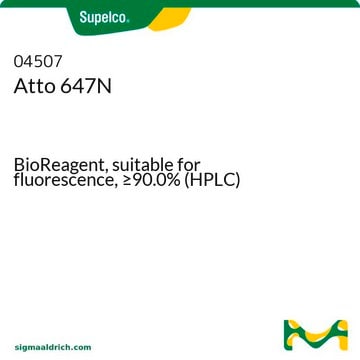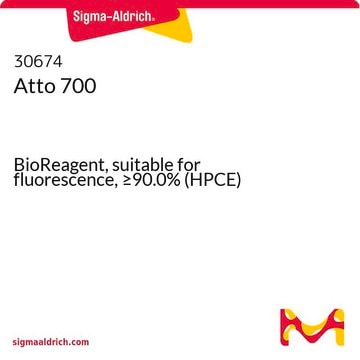92716
Atto 620
BioReagent, suitable for fluorescence, ≥90% (HPCE)
Sign Into View Organizational & Contract Pricing
All Photos(1)
About This Item
Recommended Products
product line
BioReagent
Assay
≥90% (HPCE)
form
powder
manufacturer/tradename
ATTO-TEC GmbH
fluorescence
λex 617 nm; λem 641 nm in 0.1 M phosphate pH 7.0
suitability
suitable for fluorescence
storage temp.
−20°C
General description
Atto 620 is a new label with high molecular absorption (120,000) and quantum yield (0.50) as well as sufficient Stokes shift between excitation and emission maximum. Atto 620 is characterized by a high photostability.
Application
Atto fluorescent labels are designed for high sensitivity applications, including single molecule detection. Atto labels have rigid structures that do not show any cis-trans-isomerization. Thus these labels display exceptional intensity with minimal spectral shift on conjugation.
Storage Class Code
11 - Combustible Solids
WGK
WGK 3
Flash Point(F)
Not applicable
Flash Point(C)
Not applicable
Personal Protective Equipment
dust mask type N95 (US), Eyeshields, Gloves
Certificates of Analysis (COA)
Search for Certificates of Analysis (COA) by entering the products Lot/Batch Number. Lot and Batch Numbers can be found on a product’s label following the words ‘Lot’ or ‘Batch’.
Already Own This Product?
Find documentation for the products that you have recently purchased in the Document Library.
Maria Strianese et al.
Inorganic chemistry, 51(21), 11220-11222 (2012-10-18)
Fluorescently labeled cobalt peptide deformylase (Co-PDF) can be efficiently used as a fluorescence-resonance-energy-transfer-based sensing device for hydrogen sulfide (H(2)S). The proof of concept of our sensor system is substantiated by spectroscopic, structural, and theoretical results. Monohydrogen sulfide coordination to Co-PDF
Maria Strianese et al.
Journal of inorganic biochemistry, 104(6), 619-624 (2010-03-23)
In this paper we explore the use of fluorescently labeled cytochrome c peroxidase (CcP) from baker's yeast for monitoring nitric oxide (NO) down to the sub-micromolar level, by means of a FRET (Förster Resonance Energy Transfer) mechanism. The binding affinity
Peter P T Surawski et al.
Molecular bioSystems, 4(7), 774-778 (2008-06-20)
The concept of optically encoding particles for solid phase organic synthesis has existed in the literature for several years. However, there remains a significant challenge to producing particles that are capable of withstanding harsh solvents and reagents whilst maintaining the
Darby Kozak et al.
Langmuir : the ACS journal of surfaces and colloids, 24(4), 1204-1211 (2007-12-11)
This study presents the use of flow cytometry as a high-throughput quantifiable technique to study multicomponent adsorption interactions between proteins and surfaces. Flow cytometry offers the advantage of high-throughput analysis of multiple parameters on a very small sampling scale. This
Our team of scientists has experience in all areas of research including Life Science, Material Science, Chemical Synthesis, Chromatography, Analytical and many others.
Contact Technical Service





